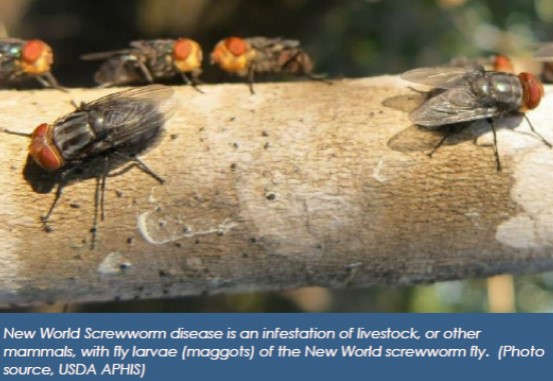By Timothy McDermott
On September 30th, 2016 entomologists at the United States Department of Agriculture, Animal Plant Health Inspection Services (USDA-APHIS-VS) National Veterinary Services Laboratories (NVSL) in Ames, Iowa confirmed a diagnosis of screwworm in a Key Deer from Big Pine Key, Florida. The New World Screwworm (Cochliomyia hominivorax) was identified as the cause. (1)
The New World Screwworm is a devastating predator of warm blooded animals including livestock, companion animals and humans. It was eradicated in the United States starting the 1950’s by releasing large numbers of male flies that were sterilized via radiation to disrupt mating. What differentiates this from other fly/maggot problems is that while other maggots feed on dead tissue, Screwworm feeds on living tissue causing tremendous damage, infection and even death in mammals and occasionally birds. The fly is attracted to the tiniest cut in the animal such as a small nick from shearing sheep to castration, dehorning and ear tagging. It is especially devastating to young and newborn animals being attracted to the umbilicus after birth. The predator has one weakness which is that the female only mates one time in her life. This allowed the mass release of sterilized males to work as a control mechanism.

Why is this important to discuss now that eradication of the 2016 New World Screwworm has been completed? Simply put, rapid identification protocols as well as general background knowledge of this predator need to increase to prevent a similar outbreak happening in a more densely populated area. The 2016 outbreak occurred on a sparsely populated island isolated off the mainland of Florida accessible by a single lane highway. 154 Million sterile flies were released, 680 active hours of surveillance, oral anti-parasite medication and an animal checkpoint(16,902 animals) at Mile Marker 106 were instituted as control procedures that achieved elimination after a six and half month period. (2) Monthly control costs ran over $1,000,000 dollars per month in Florida.(3) This was an ideal control situation and yet the predator did manage to jump to the mainland briefly. What would happen if an infected human or companion animal returned to Chicago, Dallas or Columbus?
A quote from the October 16th, 2016 AgriLife Today article written by Steve Byrns: “The return of screwworms would deal a severe blow to the ranching and hunting industries, said a Texas A&M Agrilife Extension Service veterinary entomologist at Stephenville. The observation by Dr. Sonja Swiger came as the result of the flesh-eating pest being confirmed in Florida. Swiger said Dr. Thomas Hairgrove, Agrilife Extension veterinary specialist at College Station, gave a presentation to producers Oct. 7 at Stephenville during which he said the cost to control the pest today in cattle alone could easily exceed $500 million annually. Dr. Hairgrove also mentioned a price tag of $1 billion would be needed annually to eradicate screwworms from their former range, should it become established.”(4)
With a pest that can travel internationally in its host and rapidly establish in a new environment it is critical that producers and veterinarians familiarize themselves with the anatomy and patterns of this predator to avoid a much larger agricultural emergency. Early detection will be critical to avoid a costly eradication program. If you suspect a New World Screwworm infestation please contact your local veterinarian or USDA office that handles reportable pests and diseases.